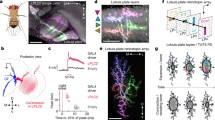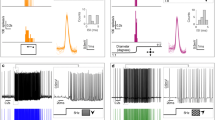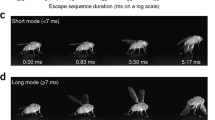Summary
-
1.
By penetrating axons in the ventral nerve cord of the dragonfly, Aeshna umbrosa, we measured the intracellular responses of target-selective visual interneurons to movement of black square ‘targets’ ranging from 1° to 32° visual angle at several levels of mean background luminance.
-
2.
Neuronal responses, measured both in number of spikes and in the magnitude of integrated postsynaptic potentials, showed a preference for larger target size at lower mean luminance (Table 1, Figs. 1–3). The latency of postsynaptic potential (psp) and spike responses from onset of target movement increased with a decrease in mean luminance (Fig. 1).
-
3.
A measure of mean target size preference (Eqn. 1) for one identified interneuron (MDT4) in both laboratory and outdoor lighting shows a continuous decrease of preferred size with increases of mean luminance over more than 4 orders of magnitude.
-
4.
The time to reach the new steady state of cell response after the decrease of mean luminance was ordinarily less than 30 s, but sometimes longer (Fig. 4).
Similar content being viewed by others
Abbreviations
- TI :
-
target interneuron
- VNC :
-
ventral nerve cord
- psp :
-
postsynaptic potential
- N.D. :
-
neutral density
- Δ ρ :
-
photoreceptor angular sensitivity
References
Derrington AM, Lennie P (1982) The influence of temporal frequency and adaptation level on receptive field organization of retinal ganglion cells in cat. J Physiol 333:343–366
Horridge GA (1969) Unit studies on the retina of dragonflies. Z Vergl Physiol 62:1–37
Horridge GA (1978) The separation of visual axes in apposition compound eyes. Phil Trans R Soc Lond B 285:1–59
Laughlin SB (1974) Neural integration in the first optic neuropil of dragonflies III. The transfer of angular information. J Comp Physiol 92:376–396
Olberg RM (1983) Identified interneurons steer flight in the dragonfly. Soc Neurosci Abstr 9:326
Olberg RM (1986) Identified target-selective visual interneurons descending from the dragonfly brain. J Comp Physiol A 159:827–840
Pinter RB (1983) Product term nonlinear lateral inhibition enhances visual selectivity for small objects or edges. J Theor Biol 100:525–531
Pinter RB (1984) Adaptation of receptive field spatial organization via multiplicative lateral inhibition. J Theor Biol 110:435–444
Pinter RB, Warrant EJ (in press) Changes of acuity during light and dark adaptation in the dragonfly compound eye. Z Naturforsch
Ratliff F, Knight BW, Graham N (1969) On tuning and amplification by lateral inhibition. PNAS 62:733–740
Schümperli RA, Swihart S (1978) Spatial properties of dark- and light-adapted visual fields of butterfly interneurons. J Insect Physiol 24:777–784
Author information
Authors and Affiliations
Rights and permissions
About this article
Cite this article
Olberg, R.M., Pinter, R.B. The effect of mean luminance on the size selectivity of identified target interneurons in the dragonfly. J Comp Physiol A 166, 851–856 (1990). https://doi.org/10.1007/BF00187332
Accepted:
Issue Date:
DOI: https://doi.org/10.1007/BF00187332




